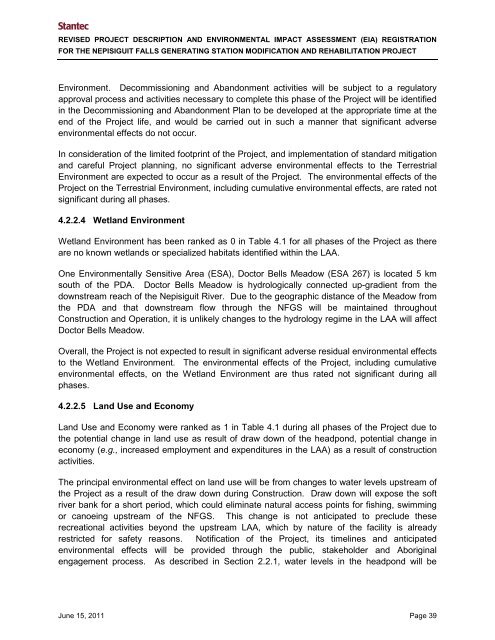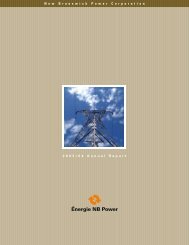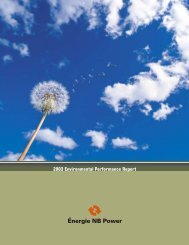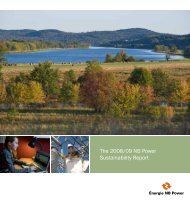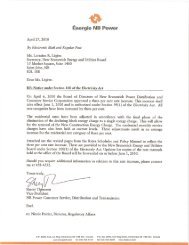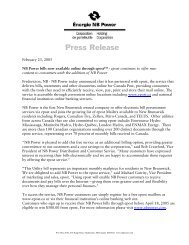Environmental Impact Assessment(EIA) Registration for the ...
Environmental Impact Assessment(EIA) Registration for the ...
Environmental Impact Assessment(EIA) Registration for the ...
You also want an ePaper? Increase the reach of your titles
YUMPU automatically turns print PDFs into web optimized ePapers that Google loves.
REVISED PROJECT DESCRIPTION AND ENVIRONMENTAL IMPACT ASSESSMENT (<strong>EIA</strong>) REGISTRATION<br />
FOR THE NEPISIGUIT FALLS GENERATING STATION MODIFICATION AND REHABILITATION PROJECT<br />
Environment. Decommissioning and Abandonment activities will be subject to a regulatory<br />
approval process and activities necessary to complete this phase of <strong>the</strong> Project will be identified<br />
in <strong>the</strong> Decommissioning and Abandonment Plan to be developed at <strong>the</strong> appropriate time at <strong>the</strong><br />
end of <strong>the</strong> Project life, and would be carried out in such a manner that significant adverse<br />
environmental effects do not occur.<br />
In consideration of <strong>the</strong> limited footprint of <strong>the</strong> Project, and implementation of standard mitigation<br />
and careful Project planning, no significant adverse environmental effects to <strong>the</strong> Terrestrial<br />
Environment are expected to occur as a result of <strong>the</strong> Project. The environmental effects of <strong>the</strong><br />
Project on <strong>the</strong> Terrestrial Environment, including cumulative environmental effects, are rated not<br />
significant during all phases.<br />
4.2.2.4 Wetland Environment<br />
Wetland Environment has been ranked as 0 in Table 4.1 <strong>for</strong> all phases of <strong>the</strong> Project as <strong>the</strong>re<br />
are no known wetlands or specialized habitats identified within <strong>the</strong> LAA.<br />
One <strong>Environmental</strong>ly Sensitive Area (ESA), Doctor Bells Meadow (ESA 267) is located 5 km<br />
south of <strong>the</strong> PDA. Doctor Bells Meadow is hydrologically connected up-gradient from <strong>the</strong><br />
downstream reach of <strong>the</strong> Nepisiguit River. Due to <strong>the</strong> geographic distance of <strong>the</strong> Meadow from<br />
<strong>the</strong> PDA and that downstream flow through <strong>the</strong> NFGS will be maintained throughout<br />
Construction and Operation, it is unlikely changes to <strong>the</strong> hydrology regime in <strong>the</strong> LAA will affect<br />
Doctor Bells Meadow.<br />
Overall, <strong>the</strong> Project is not expected to result in significant adverse residual environmental effects<br />
to <strong>the</strong> Wetland Environment. The environmental effects of <strong>the</strong> Project, including cumulative<br />
environmental effects, on <strong>the</strong> Wetland Environment are thus rated not significant during all<br />
phases.<br />
4.2.2.5 Land Use and Economy<br />
Land Use and Economy were ranked as 1 in Table 4.1 during all phases of <strong>the</strong> Project due to<br />
<strong>the</strong> potential change in land use as result of draw down of <strong>the</strong> headpond, potential change in<br />
economy (e.g., increased employment and expenditures in <strong>the</strong> LAA) as a result of construction<br />
activities.<br />
The principal environmental effect on land use will be from changes to water levels upstream of<br />
<strong>the</strong> Project as a result of <strong>the</strong> draw down during Construction. Draw down will expose <strong>the</strong> soft<br />
river bank <strong>for</strong> a short period, which could eliminate natural access points <strong>for</strong> fishing, swimming<br />
or canoeing upstream of <strong>the</strong> NFGS. This change is not anticipated to preclude <strong>the</strong>se<br />
recreational activities beyond <strong>the</strong> upstream LAA, which by nature of <strong>the</strong> facility is already<br />
restricted <strong>for</strong> safety reasons. Notification of <strong>the</strong> Project, its timelines and anticipated<br />
environmental effects will be provided through <strong>the</strong> public, stakeholder and Aboriginal<br />
engagement process. As described in Section 2.2.1, water levels in <strong>the</strong> headpond will be<br />
June 15, 2011 Page 39


